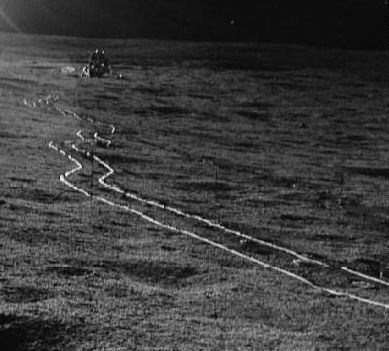Title /
Abstract /
Contents /
Part 1 /
Part 2 /
Part 3 /
Prev./
Next
THE LUNAR NAVIGATOR'S ENVIRONMENT
The lunar environment presents a navigator with unique opportunities as well as impediments. But overall, lunar navigation is not radically different than navigation on Earth, and in some ways is even simpler.
To the navigator's advantage, the lack of a lunar atmosphere allows an unrestricted view of local surroundings and celestial bodies, day or night. Tire tracks left by a wheeled vehicle will not erode away for a very long time, providing a trail for others to follow, as seen in Figure 1 [Apollo 14, 1971]. This is significant in two ways: 1. Once a particular route has been traversed, the task of navigating that same route again will be much easier for subsequent travelers. 2. It is desirable to travel directly and efficiently between points, if possible, when others are expected to follow your path. The latter is motivation to navigate accurately the first time a given route is traveled.
Unlike Earth, the Moon has no ionosphere to bounce radio waves over the horizon, therefore the use of navigation radio beacons would be limited to line-of-sight distances only [Buratti, 1989]. Given the small size of the Moon, this means that a navigator could not go very far before going "over the horizon" relative to the beacon, and thus be out of contact with it. For example, assuming a perfect lunar sphere 3476 km in diameter, a radio beacon on a 100m high tower, and a lunar vehicle equipped with a receiving antenna 10m above the surface, the vehicle could only travel approximately 24.5 kilometers away from the tower before guidance from the beacon would be lost! This mode of navigation would be clearly impractical for long distances, but might be useful for local area work, such as in the vicinity of a lunar base or industrial complex.

Figure 1: A view of the Apollo 14 landing site showing trails in the lunar dust [from Apollo 14, 1971].
The arrangement and dynamics of the Earth-Moon-Sun system impose other unique conditions on the lunar navigator. The 29.5-day rotation of the Moon relative to the Sun means that the Sun will be available as a navigation reference only for the 14.75 day period of lunar daylight. For the following 14.75 day period of lunar night, only the Earth or the stars will be available. An advantage of this slow rotation rate is that lunar ephemeris data may not have to be continuously updated for short traverses. If the navigator is using the sun for celestial navigation information, during a three hour period the Moon will rotate only about 1.5¡, providing a reasonably unchanging reference for that short amount of time [Hung, 1971].
Since one side of the Moon always faces Earth, the Earth is continuously available for navigational information for the entire lunar near side. From any given position on the near side, the Earth will appear at a relatively stationary position in the lunar sky. However, since the Moon exhibits periodic "wobbling" motions as seen from Earth, Earth's position in the lunar sky would change cyclically. These motions are known as librations [Mitton, 1977].
Libration in latitude results from the fact that the lunar equator is inclined at an angle of 6¡41' to its orbit. For an observer on Earth, this is expressed as a 6¿41' north-south nodding motion of the lunar sphere, and for an observer on the Moon, a 6¡41' motion in declination of the Earth in the lunar sky. Libration in longitude is a result of the fact that the Moon rotates at a constant angular rate, but in accordance with Kepler's second law, the Moon's angular motion about the Earth changes throughout its orbit. From the Earth, this is expressed as a 7¡36' east-west nodding of the lunar sphere, and a corresponding 7¡36' east-west motion of the Earth in right-ascension in the lunar sky.
Daytime lunar navigation presents a particular problem when the sun is at or near local vertical. Under this condition, shadows are at a minimum length and identifying various features such as craters or boulders may be impossible due to the complete lack of contrast. This phenomenon creates difficulties both in mobility, due to a reduced ability to detect hazards; and in general navigation, due to a reduced ability to identify navigational landmarks. Trail following would be likewise difficult. Lunokhod operations ceased because of this when the sun was at high elevation angles [Wilson, 1987].

Figure 2. Apollo 17 Photograph showing high sun angles and corresponding lack of shadows [from Apollo 17, 1973].
Night conditions on the Moon are quite different depending on whether one is on the near side or the far side of the Moon. On the near side, the presence of the Earth in the lunar sky provides a great deal of light; much more light, in fact, than the Moon provides in Earth's night sky. Earthlight might allow identification of navigation landmarks even during lunar night. On the far side of the Moon, though, the only night time illumination will be from the stars and planets, and landmark identification will likely be impossible without some sort of light-amplification equipment. Even then, features will be difficult to discern unless they are silhouetted against the horizon, as relatively uniform stellar illumination will prevent the formation of shadows.
Prev./
Next